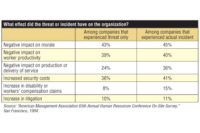Christopher Dorner allegedly killed three people last week after being, in his opinion, wrongfully fired from the Los Angeles Police Department, sparking a statewide manhunt for the 6-foot, 270-pound former officer. A manifesto – that police believe was authored by Dorner, The Associated Press reports – threatens the families of officers and officials that the author believed had wronged him: “I will utilize every bit of small arms training, demolition, ordinance and survival training I’ve been given,” the manifesto reads. “You have misjudged a sleeping giant.”
The shootings and subsequent manhunt have lead the LAPD to review the firing of the ex-cop, not to appease the alleged killer, CNN reports, but to ensure agency transparency and fairness. But should firing practices only be reviewed after a serious incident? Or could security and human resources departments adopt workplace violence mitigation strategies before a slighted former worker returns?
Even though recent statistics issued by the Department of Justice on Workplace Violence suggest workplace violence is trending downward, but since 2008 we have seen an increase in multiple workplace shooting incidents involving lone gunmen and many victims. Workplaces must stay vigilant by enforcing their own workplace human resources/security policies. Organizations should create environments where all managers discuss the impact of policy on operations, security and people before unintentionally implementing policy that contributes to discord.
Combating workplace violence as we know it is complex and requires management commitment, investment and understanding of what it takes to provide resources in protecting the workforce against threats posed by disgruntled employees, domestic violence spillover into the workplace, and customer-, client- or patient-related violence. Traditional approaches have always relied on the Human Resource departments to be the lead – the policy implementer.
However, as recent workplace homicides indicate, having proactive workplace violence prevention and violence response plans will ensure a better coordination between security and human resources. Future models may require the involvement of the security department in the assessment and evaluation of employee complaints and reports and at risk situations and conditions. This model performs more efficiently when there is ongoing collaboration and coordination between multiple departments.
Prevention should not begin with the new employee "Hire" and end with the bad employee "Fire,” nor should the healthcare approach to employee safety and patient care end with the "patient release.” The investment made during the new employee hiring should be a definite consideration during the firing process. Confrontational employee engagements are charged moments in an employee's interaction with the workplace; how an employer chooses to engage will determine how the employee responds and co-workers react.
Read More: How Awareness Stops Negligence, Prevents Workplace Violence in Healthcare
Also, there is a perception that the healthcare community values patient services over employee safety and security. These perceptions of distrust ultimately affect workplace safety, security and the organization's ability to deliver its services.
10 TIPs IN PREVENTING THE ESCALATION OF WORKPLACE VIOLENCE:
1. Assess and evaluate all employee-reported incidents of violence in determining the need to conduct an investigation. Ineffective responses to employee concerns and complaints erode trust and confidence and disrupt workplace efficiencies. Such practices can lead to employees taking the "law" into their own hands.
2. Having a clearly defined and credible reporting and monitoring system provides employees reassurances that their reports and complaints are taken seriously. Organizations can reduce their civil liability by engaging the proactive measures that promote accountability.
3. Holding supervisors and managers responsible and accountable for responding to and handling initial employee complaints. There should not be any discretion at this level so as to engender an organizational commitment to workplace violence prevention.
4. Employers must be ever mindful that victims and witnesses become problem employees for the workforce. These "Problem Employees" identified as trouble-makers or labeled as "problem children" in schools can become victims of bullying and other forms of harassment.
5. Prejudgment and pre-determination of employee complaints places them at risk by failing to promptly addressing the complaint, contributing to perceptions of disparate treatment. Unfair prejudgment of employee disputes and situations results in long-term discord between coworkers and management.
6. Be sensitive to employee working conditions and the impact of established policy on perceptions of unfairness. Learn to recognize and react to early warning signs of potential problems as a result of personnel changes, impending business decisions and organizational change.
7. Make employee encounters with management a dignified process, especially during the disciplinary and termination steps. Know the impact of heavy-handedness. Giving detailed explanations and allowing room for feedback reduces anxiety and tensions.
8. Consider the value of threat assessment or incident management teams in monitoring and tracking incidents to de-escalate future problems. Create a team that's representative of key members of the organizational leadership team with authority to act.
9. Bring the Security department in a sharing of roles with HR. This can be a value-added benefit during the initial and follow-up assessment and evaluation phase of employee reports and complaints. If the police are called, be prepared to manage the support they provide. Avoid turning over the human resource/security matter to local police who might not offer the best advice in every situation. While coordination is recommended, having a response plan ensures an efficient hand-off in hostile emergency response situations.
10. Don't be afraid to dig for root causes of a particular incident or situation before at arriving at culpability. Being ever mindful that workplace policy can have adverse impact of perceptions and performance keeps clarity and focus and avoids assumptions.
In providing oversight and review, Boards of Directors, CEOs and Executive Directors have obligations to provide resources for establishing the tone for workplace climate of accountable behavior within their organizations as it relates to criminal acts and behaviors that impact on employee safety and security. Boards of Directors can provide oversight as it pertains to OSHA Compliance. Conducting annual assessments of the state of Workplace Violence Prevention Programs can aid in updating policies, plans and strategies and recognizing unknown hazards.
Remember, the homicidal act of employee on employee workplace violence is preventable. There is no excuse for any employee behavior, situation or condition to go unresolved or unaddressed without the proper resources; be they internal or external. The objective of a thoughtful Workplace Violence Prevention Effort is the recognition of accountable and responsible supervision and managerial engagement.



